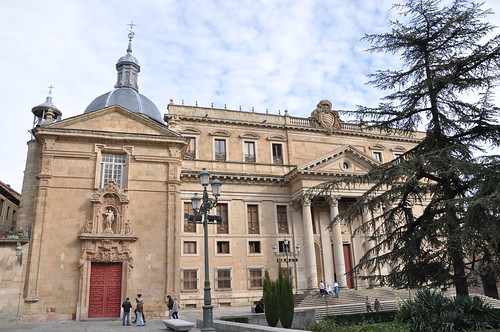
Esta animada praça recebe o seu nome pelo Palácio de Anaya que vemos na foto do lado direito. Este palácio albergou o Colégio de Anaya também conhecido como Colégio Maior de S. Bartolomeu fundado no século XV por Diego de Anaya com o objectivo de dar acesso aos estudos aos que não tinham recursos.
Hoje funciona a faculdade de Filologia, responsável pelo estudo cientifico da língua.
This lively square gets its name because of the Palacio de Anaya we see in the photo on the right. This palace housed the College of Anaya also known as Colegio Mayor de S. Bartholomew founded in the fifteenth century by Diego de Anaya with the aim of providing access to students that lacked resources.
Today the work of philology faculty, responsible for scientific study of language.
This lively square gets its name because of the Palacio de Anaya we see in the photo on the right. This palace housed the College of Anaya also known as Colegio Mayor de S. Bartholomew founded in the fifteenth century by Diego de Anaya with the aim of providing access to students that lacked resources.
Today the work of philology faculty, responsible for scientific study of language.

Talvez por isso encontramos na praça um marco do "Camino de la Lengua Castellana". Existe uma fundação responsável pela promoção desse "caminho" e o marco contém um mapa com as cidades associadas entre elas Valladolid, Ávila, Alcalá de Henares, etc..
Do lado oposto ao Palácio podemos ver a Catedral Nova e duas portas de acesso, a do Norte e de Ramos.
Maybe that's why we find in the square a landmark "Camino de la Lengua Castellana". There is a foundation responsible for promoting this "path" and this contains a map with associated cities including Valladolid, Ávila, Alcalá de Henares, etc. ..
Opposite to the palace we see the New Cathedral and two access doors, the North and Ramos.
Maybe that's why we find in the square a landmark "Camino de la Lengua Castellana". There is a foundation responsible for promoting this "path" and this contains a map with associated cities including Valladolid, Ávila, Alcalá de Henares, etc. ..
Opposite to the palace we see the New Cathedral and two access doors, the North and Ramos.

A praça tem também um pequeno jardim e dizem que é muito utilizado para eventos ao ar livre e ao lado do Palácio podemos ainda ver a Igreja de S. Sebastian de estilo barroco. Foi inicialmente construída como capela de apoio á universidade e no século XVIII é remodelada por Alberto de Churriguera o mesmo arquitecto da Plaza Mayor e da Catedral Nova que podemos ver na cidade.
The square also has a small garden and it's to be widely used for outdoor events and next to the palace we can see the church of S. Sebastian Baroque. It was originally built as a chapel to support the university in the eighteenth century and is reshaped by Alberto Churriguera the same architect of the Plaza Mayor and the New Cathedral that we see in the city.
The square also has a small garden and it's to be widely used for outdoor events and next to the palace we can see the church of S. Sebastian Baroque. It was originally built as a chapel to support the university in the eighteenth century and is reshaped by Alberto Churriguera the same architect of the Plaza Mayor and the New Cathedral that we see in the city.




Sem comentários:
Enviar um comentário